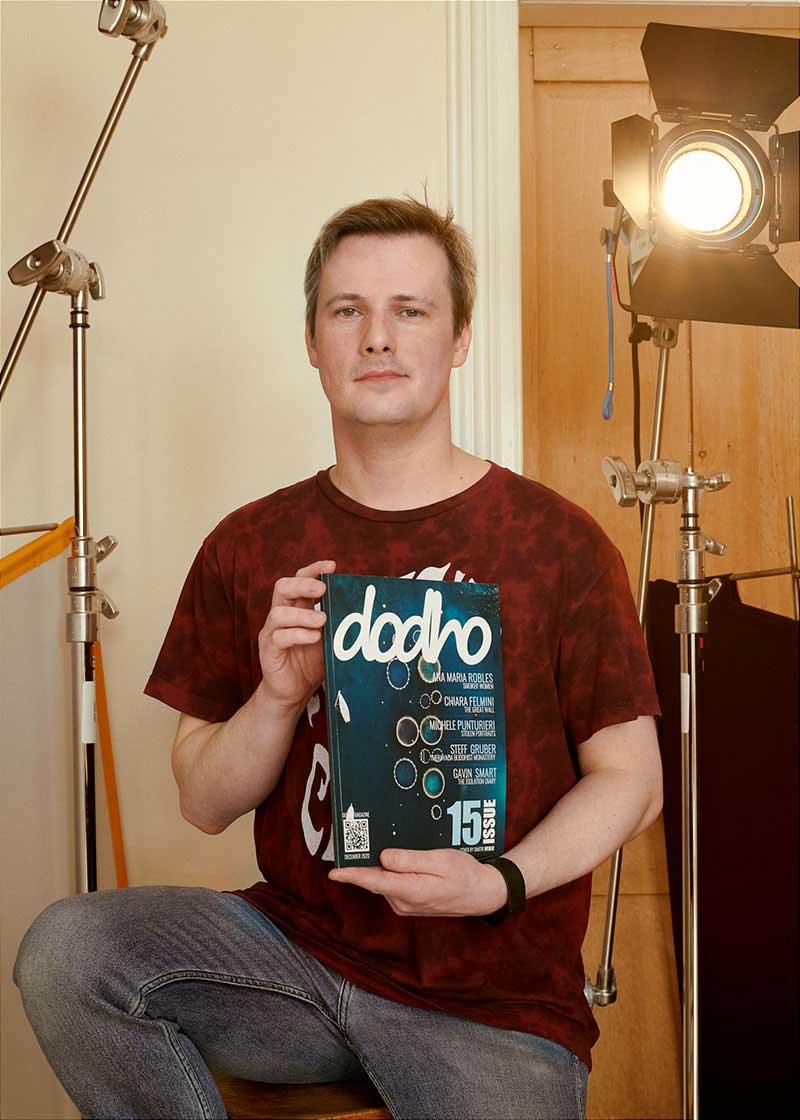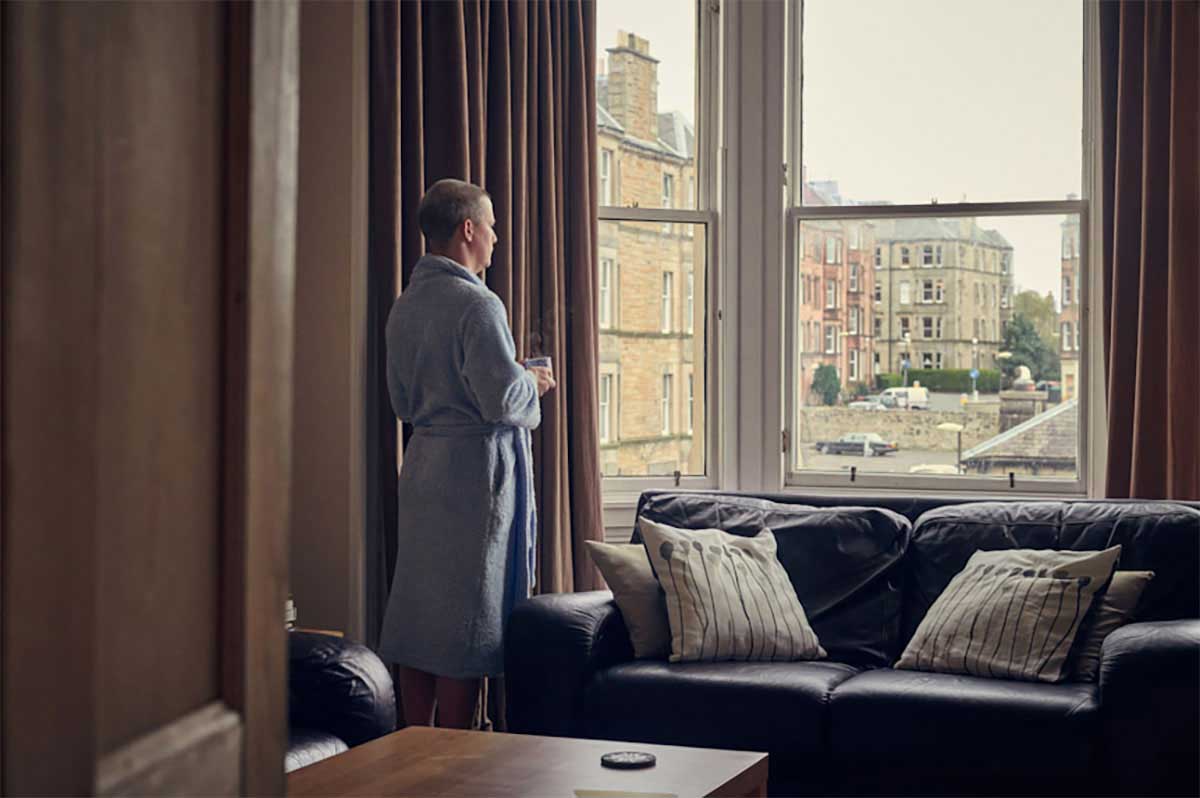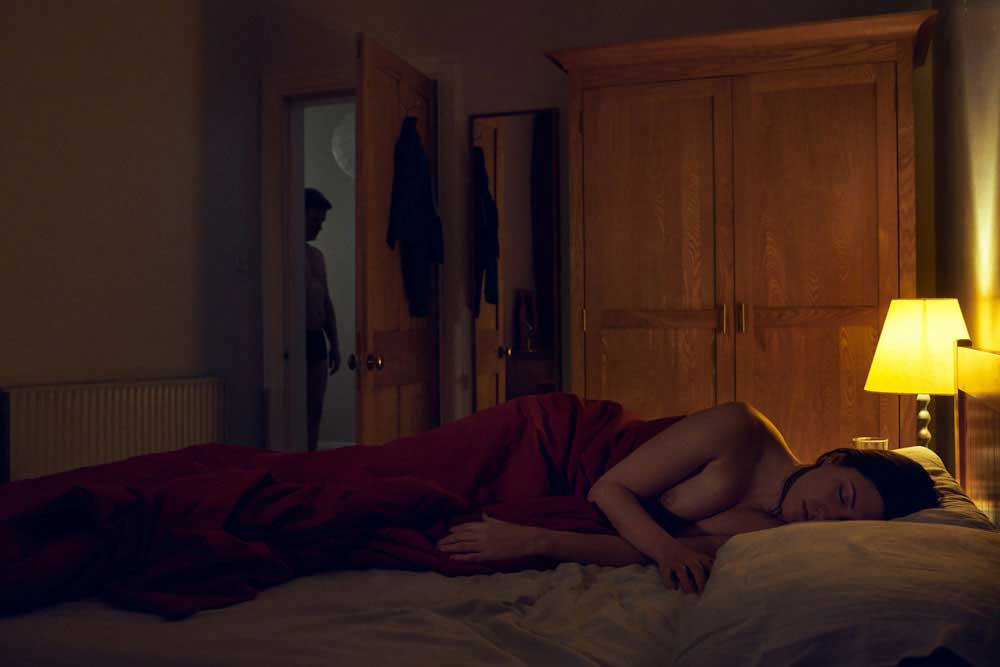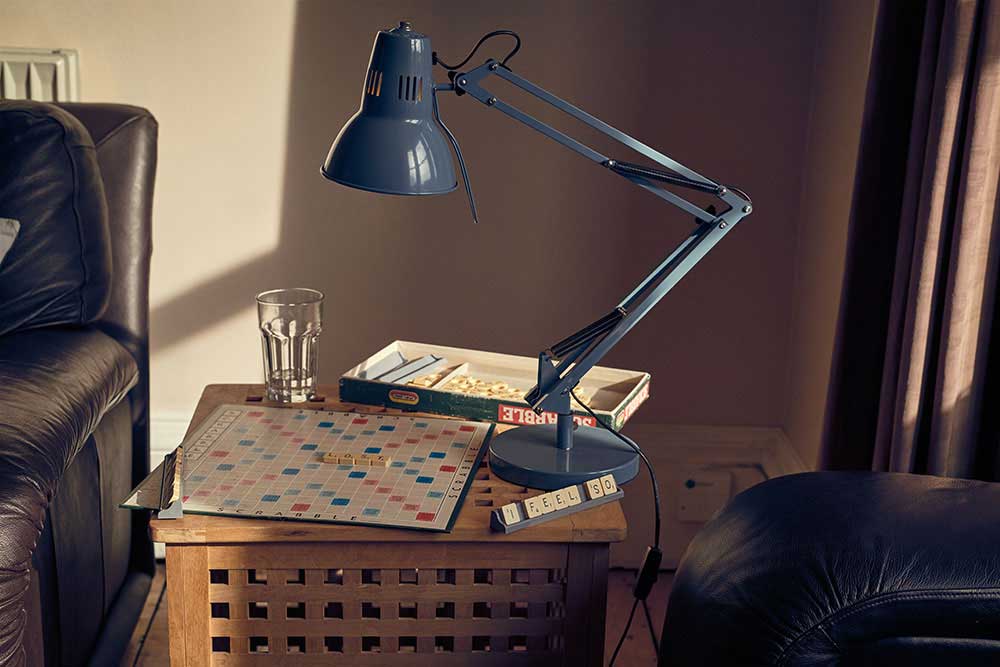Gavin Smart is an award-winning freelance photographer. He has a rich and diverse creative background which began with his rigorous musical training, studying the tuba at London’s prestigious Guildhall School of Music.
While he no longer plays music professionally, this period of his life gave Gavin the colourful life experiences which continue to shape his photographic process. His cinematically-inspired images feature theatrical light, emotive colour and constructed photography, drawing a strong influence from painting, film and literature. His work marries the production of advertising for some of the UK’s top arts institutions, theatres and design agencies alongside carefully considered personal projects. Using imaginative storytelling to produce creative and thought-provoking imagery, his photography has since become a vital means of personal expression and an aid in making sense of an ever-evolving world. [Printed edition] [Digital Edition] [Official Website]
I’d like to begin this interview by commending you on showcasing such a personal project. As a freelance creative myself, the issue of employment, sense of Stability and purpose may have been shattered for a time. For many people suffering through the pandemic, this has truly been the hardest year. If it’s not too personal of a question, I’d love to know what drove you to begin a diary when the pandemic struck in March of last year and if your ‘Isolation’ series was a direct result of the emotions and circumstances that you jotted down?
Thank you so much! That really means a lot. On a very personal level, photography for me has always been a vital means of communication, a way to help process and make sense of the things around me. It’s been a coping mechanism when things get really tough, and even in my commercial work I always try to channel that emotion into the work I’m producing.
When the pandemic struck in March last year, as you said it was such a hard time for so many of us, and one of things that really helped was being able to produce a creative body of work that could find space to articulate those complicated and distressing emotions. When we’re living through a very difficult and challenging moment it’s often extremely hard to speak with any kind of distance or perspective. Yet by producing a series of images that attempted to illustrate the mental health issues I was experiencing, I found the space and time to process and find peace with these feelings. It was almost like Rosie (my partner) and I, as we looked over the project, were watching an indie short film of ourselves!
The diary aspect was simply a way to get those feelings out of my head and down on to paper, then once I had those words in front of me, I could begin a process of trying to imagine those memories as living and breathing still images.
Sticking to a fixed focal length was an interesting decision. As a result, many of the photographs of you, taken from a distance (in corridors and through other doors) have a very cinematographic effect to them. Did you have a goal in mind as to how these photographs would look from the very beginning, or were you more concerned about showcasing elements of isolation, sadness, rejection…
That’s a really good question! I think the cinematic aspect of the series was always at the forefront of my mind when pre-visualizing the series as a completed whole. I wanted to convey the feeling of an intimate indie short film, so many of the aesthetic decisions of framing, composition and focal length were made to help create that aesthetic of that particular style of imagery.
It’s funny as whilst I do own a selection of prime lenses from about 20mm to 200mm, I almost always end up using a 50mm for almost all of my work! I’m think I’m often naturally drawn to that lens for the fact that it’s normal focal length is often the closest thing to our natural human field of vision. Using 50mm, and occasionally widening the framing to 35mm when necessary, helped to suggest that the shots were seen through our own eyes, inviting the viewer into the scene even though these are often extremely intimate and private moments in our daily life.
The thematic elements of isolation, sadness and more are of course linked to the goal of capturing intimacy in composition, but one of the biggest influences on this entire series was the beautiful work of Danish painter Wilhelm Hammershøi. He painted a series of intimate interiors of his Copenhagen apartment at the turn of the 20th century, often featuring his wife Ida, which have a haunting sense of tension and intense isolation which continue to inspire my creative practice to date.
It’s interesting how these photographs parallel landscapes that are completely barren. As a landscape photographer myself, I tend to look for the smallest of details when it comes to viewing a barren landscape. Attempting to find something that sticks out and that’s not part of the norm. It’s interesting how your photographs express similar values of ‘less is more’. We are presented with small objects in various images that serve as clues. One object that seem to be present is the half full glass of wine. Would you say that your relationship with alcohol during quarantine is also an extension of how many other people in your situation are facing this pandemic and that by showcasing your experience in such an honest way, you hope to open up a conversation about mental health?
Thank you, and I love the parallel comparison to a barren landscape! As I mentioned above, Hammershøi’s evocative and moving interiors have always been a strong influence in my work, and he strives for a very similar objective. Comparing his paintings to the vintage photographs of his home that still exist, we can clearly see that he has intentionally stripped back a room to merely a couple of pieces of furniture or a single picture on the wall. By carefully filtering out the recognizable and mundane details of a daily life, his images take on very pronounced feelings of isolation, silence and tension as we are left with sometimes more questions than clear answers.
In my own series and by this same process, I was able to gently draw focus to particular motifs and symbols that populate the project, with the wine glass being one specific example. It was always my intention with this project to speak as honestly and opening as I possibly could, with themes such my relationship with alcohol becoming an important part of that complicated story. Mental health in the UK still carries crippling social stigmatization, particularly as a male in a western capitalist society, and there is so little space to open up and admit to issues of financial and emotional struggle. I felt that the only way to speak honestly about these issues was to tell my own story, and hopefully encourage others to do the same.
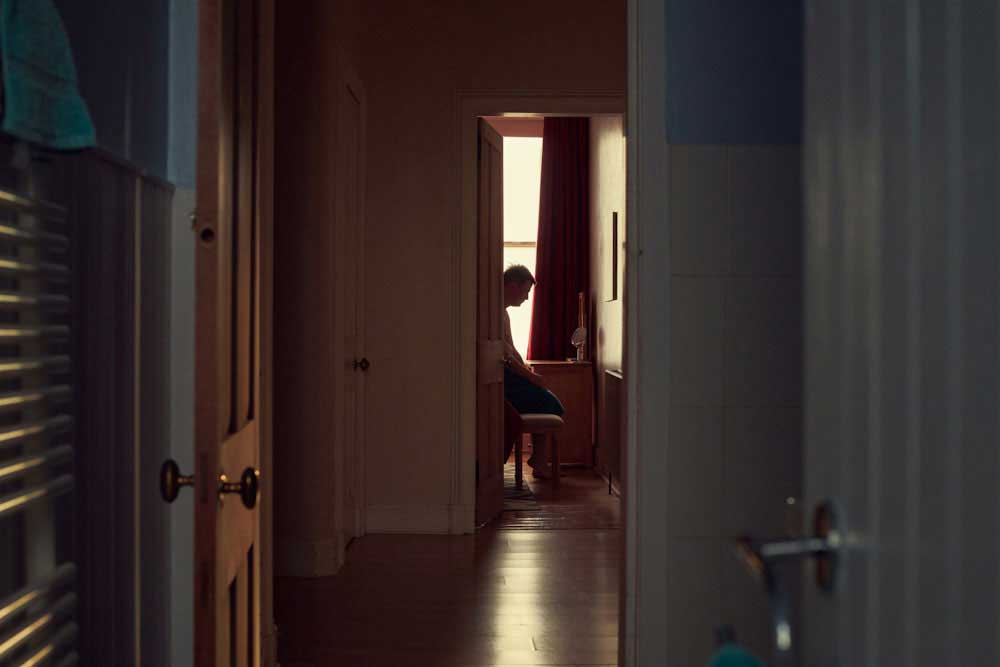
An image that I’d like to know a bit more about is the photograph of scrabble on the desk. It’s an interesting image because it’s a photograph that literally describes what you are feeling, yet the final word is cut off. Could you tell us a little bit about this image, your thought process behind it and how you came to shoot the photograph?
This shot was part of a set of early images that I captured at the beginning of the pandemic, earlier in 2020. In terms of thought -process it was very much a kind of blunt, knee-jerk reaction; a desperate need to find creative expression for the complicated emotions that I was experiencing at the time. The idea behind this particular image was to use the Scrabble board as way of suggesting feelings of fear or worry, using the letters on the board as a vehicle to express a heightening anxiety that I was unable to vocalise. The image was laid out in our living room in the manner of a traditional still-life scene, with the staging of a contemporary domestic environment.
Looking back through the sequencing as the project developed, in many ways this image was also one of a series of shots that for whatever reason, I was never truly happy with. There were a few others that had an almost overly direct message: some with a more political agenda, and others that were quite blunt and forceful in delivery.
As I took the series apart, I began to see that they lacked the subtle ambiguity that I spoke of before, particularly the thoughtful, quiet tension that permeates through Hammershøi’s beautiful interiors. I returned to the project after Christmas with fresh eyes and decided to cull a number of these images (this one included). It tightened the story into what I always hoped would be a more gentle, intimate portrayal of sensitive mental health issues rather than a simply a politically driven piece. Whilst I am proud of this project overall, I think one of the most rewarding aspects of working on for so long has been the sustained period of learning. By embracing my mistakes, reshooting images, and ultimately never being afraid to rework the material, I feel that I now have something that really communicates the essence of the story I want to tell.
I’d like to conclude this brief interview by asking you about the continuation of this project. As we are still facing corona virus and the restriction of movement, will this isolation series also evolve or are we going to see more photographs depicting personal struggle?
One of the most rewarding aspects of this work has been the fact that maybe for the first time in career, this series had no professional agenda. It wasn’t meant to court work from agency or similar professionals, it wasn’t a portfolio showcase, it was only ever meant to be something personal and intimate to help deal with the weight of the world right now.
I think in doing so, however, this series has grown, developed and really connected with so many more people than I had hoped. I was able to create a series that I had always wanted to produce and was free to develop a personal aesthetic that felt honest and right. I sat down after Christmas and had a long hard look at the series, cutting out many of the older images that I felt were maybe too political or too direct, and instead replaced these with newer images that better helped expressed the gentle silence and thoughtfulness that had been my original inspiration.
I hope to continue this project as I still have many more images in my head. Sadly, the situation continues around the world, and even before COVID, issues of isolation, unemployment and mental health have been getting worse for quite some time. It is my hope that maybe this project becomes less about a specific incident, and more about the larger societal underlying issues behind it.
Apart from continuing to develop the still images, one of the most exciting projects I’m working on is a series of short 3-minute moving image sequences which attempt to animate the images in this project and to develop the cinematic nature of this project. I’m currently putting the final edits to the first of these sequences, and I hope to share this very soon!
More information on these and this ongoing project, please check out my monthly column on Dodho online!
Francesco Scalici
A recent MA graduate from the University of Lincoln, Francesco has now focused on landscape photography as the basis of his photographic platform. An author for DODHO magazine, Francesco’s interest in documentary photography has turned to writing and has had various articles, interviews and book reviews published on platforms such as: ‘All About Photo.com’, ‘Float Magazine’ and ‘Life Framer Magazine’. Currently on a photographic internship, Francesco has most recently been involved in the making of a short film titled: ‘No One Else’, directed by Pedro Sanchez Román and produced my Martin Nuza.



